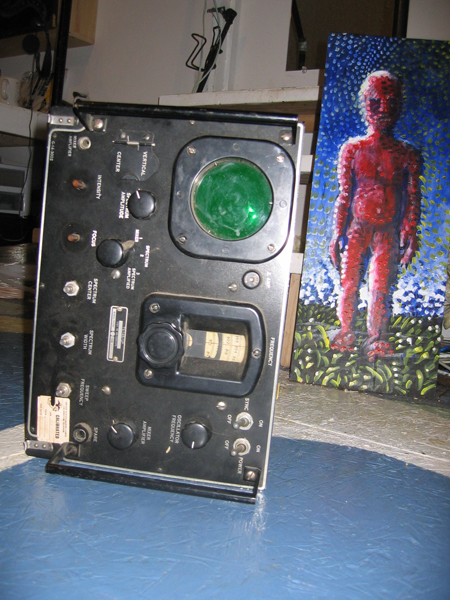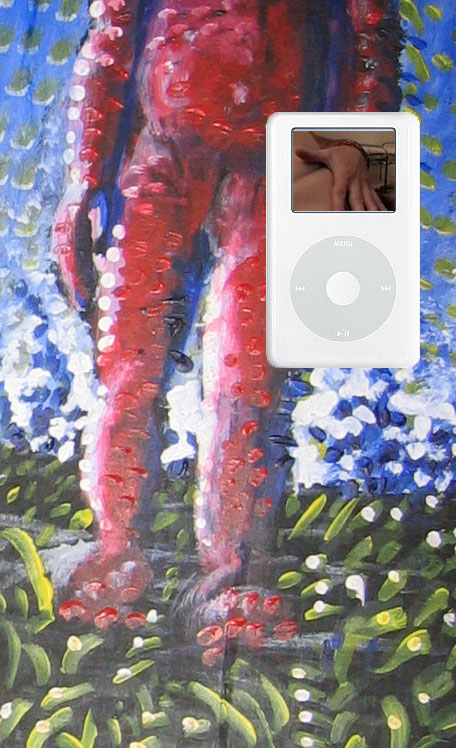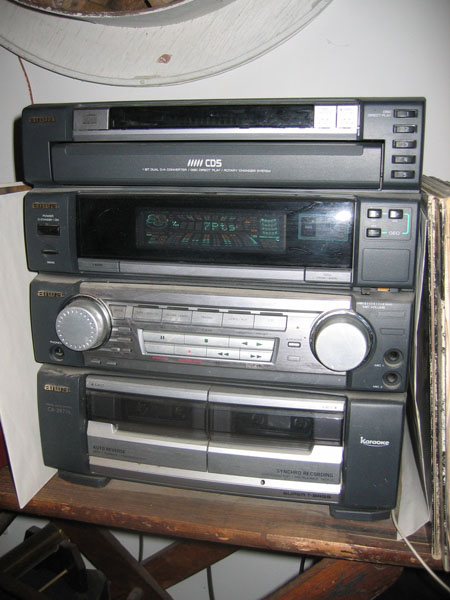|
|
|
tube oscilloscope versus the iPod and the Aiwa
Monday, January 22 2007
The oscilloscope I dumpster-dived at UVA back in the Spring of 1998 could tell some stories if only it could talk. It's a massive tube-filled piece of hardware, a riot of point-to-point wiring. It's such a maintenance nightmare that, in addition to schematic diagrams, there are several tools (mostly Allen wrenches) affixed to the body frame with metal clips. On the outside, it's a burly machine with big black knobs that have an expensive feel when they're rotated (unlike my cheapo Tektronix T922). A tag on the front claims the oscilloscope was calibrated by a tech named Cooke on the 12th of February, 1976 as part of a program undertaken by the United States Marine Corps. Despite all this, the actual display tube is tiny, a circle less than three inches across. When it worked, back before its main transformer started belching clouds of carcinogenic smoke, it was a piece of art. And to some degree it still is. Nobody makes devices so beautiful in 2006.

I actually cannibalized some of the knobs from this oscilloscope, first for my computer's volume control knob, and then for the temperature setting knobs of the first (non-Arduino) version of my solar sufficiency controller.

I still think it looks like a puddle of cum.
Despite my various complaints otherwise, I'm willing to concede that the iPod (and the various iBooks and iMacs) are also superficially attractive, but this is an attractiveness that quickly turns hideous the moment you pry them apart and discover that they're held together with tape. Theirs is a beauty designed to be as disposable as a newspaper. In achieving their design, the iPod designers decided not to pack their creations with tools and diagrams granting them the possibility of perpetual beauty, or, for that matter, to even to give them the simple dignity of a replaceable battery.
I'd actually like to make an MP3 player out of my old oscilloscope. It wouldn't be a cute little portable device; instead it would be a living room music server, complete with a power amplifier, an FM tuner, a tape deck, a CD tray, and a turntable for playing vinyl records. It would be able to connect with the home network to play MP3s on any of the shared directories. Inside, it would contain a modestly-capable computer and a hard disk drive. On the front, where the waveforms used to trace their lazy linear forms, would be a modest monochrome display allowing the user to browse, select, and display MP3s. Across the rest of the panel would be some sort of button-and-knob-based user interface. It would be delightfully-retro, using analog input and output for all the places that those make sense, while using digital for the few places where that makes sense. In this way it would put the existing living room stereo to shame.

The Aiwa (not spelled iWah!). What a piece of junk!
Let me take a moment here to state why I despise the living room stereo, which was Gretchen's existing stereo when I moved in with her back in 2001. The thing was made by a Japanese company called Aiwa, and features a five-CD changer, a record turntable, a dual-tape dubbing deck, a digital AM/FM receiver, a multi-band digital equalizer with presets, and a power amplifier. I have no beef with the functionality of this system; it works well enough once it is cajoled into doing something. But getting it to do anything is a royal pain, one usually accompanied with audible curses. This is due mostly to its exceptionally poor user interface, which makes most Windows movie editing freeware look like the iPod by comparison (and, for those of you unfamiliar with Windows movie editing freeware, this takes some doing!). The crux of the Aiwa's poor interface can be boiled down to one issue: inappropriate use of analog controls. There are two large knobs on the front of the Aiwa's tuner deck, one to change volume and the other to change station (or various other analog settings). The volume knob works as expected and I have no complaints about it (indeed, it could have been worse: a set of up and down buttons!). But the station changing knob is an interface disaster. Station positions along the radio spectrum do not correspond to the distance this knob is rotated; instead rotating the knob in one or the other direction causes the tuner to scan upward or downward an arbitrary distance to the next station of sufficient signal strength, where it will stop no matter what you do. Then you have to twist the knob again to keep going. More often than not, though, the station you're seeking will have a signal strength falling just short of the power necessary for the scan to stop, and so it will be skipped. Luckily, there are also two up and down scan arrows buttons on the tuner's front panel, though I much prefer a proper analog tuner (or a digital tuner that can act like an analog tuner) when seeking a radio station. I particularly like tuning knobs attached to flywheels that can be thrown spinning off toward some distant end of the radio dial.
In my hypothetical ultimate MP3 player (which unfortunately won't fit inside my oscilloscope), I'd like to have some sort of retro display, perhaps an old CGA monitor. Tonight I tried hooking up various vintage PC display boards to a reasonably-capable PC motherboard and then driving a composite display. (I have a couple such displays that are only nine inches diagonally, like that of the original Macintosh.) In the end I'd probably use a low-end VGA card working through a VGA-to-composite adapter instead of an actual CGA adapter; I might want to make my MP3 player interface a little more glitzy than is possible in the primitive world of CGA graphics. But I think the ideal display would be monochrome, either green or amber, and as tiny as possible.
For linking purposes this article's URL is:
http://asecular.com/blog.php?070122 feedback
previous | next |


